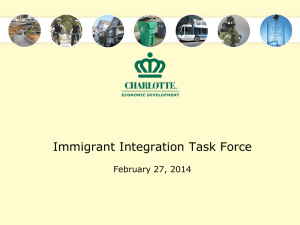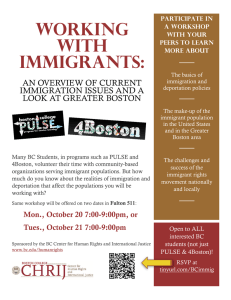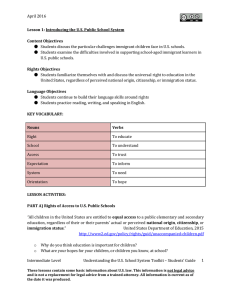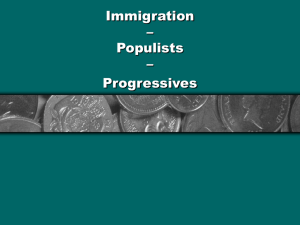II C :: :
advertisement
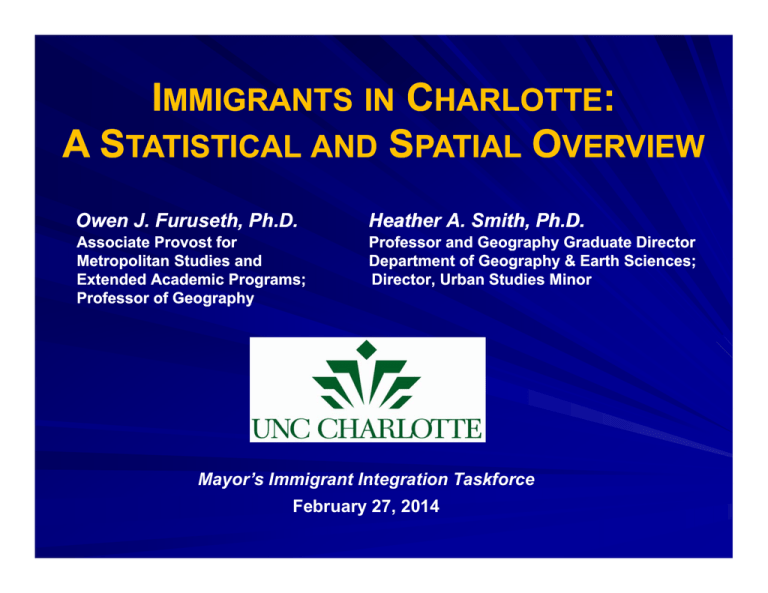
IMMIGRANTS IN CHARLOTTE: A STATISTICAL AND SPATIAL OVERVIEW Owen J. Furuseth, Ph.D. Heather A. Smith, Ph.D. Associate Provost for Metropolitan Studies and Extended Academic Programs; Professor of Geography Professor and Geography Graduate Director Department of Geography & Earth Sciences; Director, Urban Studies Minor Mayor’s Mayor s Immigrant Integration Taskforce February 27, 2014 Outline 21st century immigration geography in the U.S. Traditional vs. New Immigrant Gateway model Charlotte’s immigrant landscape: issues and policy implications affecting immigrant integration 2 America’s 21st Century Demographic Frame 2005-2050, U.S. population growth (48%) 2005438 million 82% growth th immigrants i i t and d their th i descendants Foreign--Born Population in 2011 Foreign Mexico (29%) India (4.6%) Philippines pp ((4.5%)) China (4.1%) Vietnam (3.1%) El Salvador (3.1%) Korea (2.7%) In 2000, Hispanics largest minority group in the U U.S. S (15 (15.1%); 1%); AfricanAfrican-Americans 12.1% (2005(2005-2009 estimates) 3 Charlotte’s Transformation from Old South to New South 800000 734,418 (17) 700000 540,828 (26) 600000 45.1% 500000 White 395,934 (35) 400000 African‐American 55.9% Hispanic 315,474 (47) 300000 65 6% 65.6% Asian 34.2% 67.5% 200000 33.0% 100000 31.3% 7.8% 1.4% 1.8% .098% .076% 0 1980 13.1% 31.8% 1990 5.1% 3.7% 2000 2010 4 Classic Immigrant Settlement Geography (The Chicago School) Immigrant “Gateway Cities” key entry points for people and goods moving into the U.S. Immigrants settle in the poorest and least desirable neighborhoods Immigrants settle in the City Center close to job opportunities Immigrants are attracted to prepre-existing immigrant communities Urban immigrant settlement leads to ethnic enclaves 5 21st Century Immigrant Gateways: New Settlement Model New gateway cities – rapidly growing new economies growing, economies, interior locations Little or no immigration traditions Suburban settlement – housing costs job location costs, location, successional change Highly diffused immigrant populations 6 Rise of New Immigrant Gateways: Why Charlotte? Economy – growing service-based economy – need for workers across occupational spectrum – Bank of America phenomenon (early 1990s turning point) Landscape of Opportunity – entrepreneurship encouraged – year year-round round employment – female employment opportunities Welcoming g – little immigration history or experience = less prejudice – expansive labor market – immigration non-political issue 7 Immigrant Overview for Mecklenburg County (Foreign--Born equals immigrant) (Foreign Total Foreign-Born 13.6% (128,879) Citizenship Status 32.2% Entered U.S. B f Before 2000 2000-2009 2010 or later 50.7% 0 % 43.4% 5.9% Region of Birth Latin America Asia Europe Africa North America (Canada) Oceania 51.5% 27.3% 10.9% 8.4% 1.4% 0.4% Source: U.S. Census Bureau, American Community Survey, 3-year estimates (2010-2012). 8 Immigrant Overview for Mecklenburg County: Economics and Labor Market Median Household Income $54,417 (U.S. Born: $56,602) Income and Benefits (2012 inflation adjusted) $200,000 $200 000 or more $150,000 - $199,000 $100,000 - $149,000 $75,000 - $99,000 $50,000 - $74,999 $35,000 - $49,999 $25,000 - $34,999 $15 000 - $24,999 $15,000 $24 999 $10,000 - $14,999 $10,000 6.1% 6 1% 5.4% 12.5% 11.5% 18.3% 14.3% 10.3% 10 0% 10.0% 4.9% 6.8% Source: U.S. Census Bureau, American Community Survey, 3-year estimates (2010-2012). 9 Immigrant Overview for Mecklenburg County: Economics and Labor Market Occupation Management, Business, Science and Arts Occupations p Service Occupations Natural Resources, Construction and Maintenance Occupations Sales and Office Occupations Production, Transportation and Material Moving Occupations 26.9% 23.1% 19.6% 15.9% 14.5% Source: U.S. Census Bureau, American Community Survey, 3-year estimates (2010-2012). 10 Metrics Affecting Immigrant Receptivity and Quality of Life All ForeignBorn 32 2% 32.2% Latin America 18 7% 18.7% Asia 44 2% 44.2% Europe 56 3% 56.3% Africa 41 7% 41.7% Entered U.S. before 2000, Not Citizen 23.4% 30.6% 13.2% 18.4% 15.4% Language Spoken at Home English Only Speak English Less than "Very Well" English Language Isolated Households 15.2% 49.5% 29.0% 7.9% 63.7% 40.7% 12.5% 45.8% 24.6% 35.9% 20.9% 11.7% 26.1% 22.8% 9.8% Educational Attainment < High School Graduate Graduate or Professional Degree 30.1% 11.4% 47.0% 3.6% 15.6% 21.7% 9.8% 20.5% 7.3% 12.8% $63,165 $46,257 Families Below Poverty Level 19.6% 26.9% 12.2% 4.7% 18.7% Unemployed in Labor Force 7 1% 7.1% 7 5% 7.5% 5 9% 5.9% 5 0% 5.0% 9 5% 9.5% Citizenship Mean Household Income Past 12 Months (2012 inflation adjusted) $81,007 $98,885 $55,709 11 Metrics Affecting Immigrant Receptivity and Quality of Life (continued) All Foreign- Latin Born America Asia Europe Africa Self-employed Workers 6.9% 8.2% 3.5% 11.0% 3.0% Occupation Concentrations Management, g , Business,, Science and Arts Occupations Service Occupations Natural Resources, Construction and Maintenance Occupations 26.9% 23.1% 10.7% 29.5% 48.4% 14.0% 49.7% 11.9% 36.0% 22.9% 19.6% 32.5% 2.6% 8.1% 9.4% Home Ownership "At-Risk" Home Ownership 48.7% 42.0% 38.4% 51.5% 59.8% 38.9% 74.8% 28.4% 42.5% 40.4% No Automobile Available 7.4% 7.5% 6.8% 4.5% 10.3% 12 13 14 15 16 17

